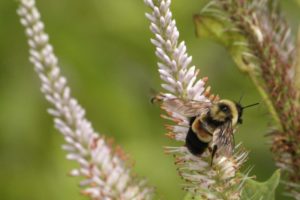
Bees have been in the news many times over the past several years. Much of the concern has been focused on the collapse of honey bee colonies because these bees collect nectar to create honey and can be transported for use as pollinators for farmers. Alongside the plight of the honey bee are the declines in the population of native bees in the United States. These bees include insects like the big, fuzzy bumble bees, tiny, iridescent green sweat bees and dark blue mason bees. The native bees live in different conditions. They may be solitary, have a small colony or even nest close together in a communal arrangement, but never in the numbers likely to be seen for a honey bee colony. These lower-density populations can make seeing a change in native bee numbers more difficult. While honey bees have gained the majority of bee decline attention, native bees have suffered dramatic population loss with long-term consequences for the plants they pollinate and the animals that depend upon those plants.
On January 11, 2017, in a landmark decision by the United States Fish and Wildlife Service, the one of the rarest native bees called the rusty-patched bumble bee (Bombus affinis) has been listed as threatened, and this designation will go into effect February 10, 2017. This is the first bee in the U.S. that has been placed on the Endangered Species list. The rusty-patched bumble bee derived its name from the rust-colored patch found on its back.
Continue reading “A Big Protective Step Forward for A Rare Bee”